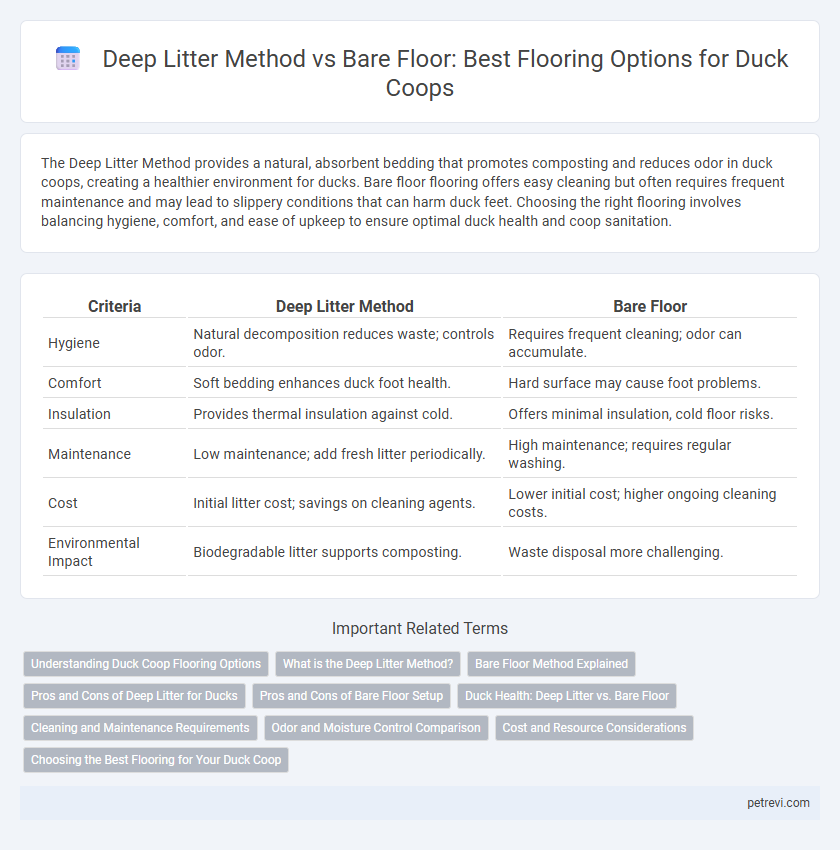The Deep Litter Method provides a natural, absorbent bedding that promotes composting and reduces odor in duck coops, creating a healthier environment for ducks. Bare floor flooring offers easy cleaning but often requires frequent maintenance and may lead to slippery conditions that can harm duck feet. Choosing the right flooring involves balancing hygiene, comfort, and ease of upkeep to ensure optimal duck health and coop sanitation.
Table of Comparison
| Criteria | Deep Litter Method | Bare Floor |
|---|---|---|
| Hygiene | Natural decomposition reduces waste; controls odor. | Requires frequent cleaning; odor can accumulate. |
| Comfort | Soft bedding enhances duck foot health. | Hard surface may cause foot problems. |
| Insulation | Provides thermal insulation against cold. | Offers minimal insulation, cold floor risks. |
| Maintenance | Low maintenance; add fresh litter periodically. | High maintenance; requires regular washing. |
| Cost | Initial litter cost; savings on cleaning agents. | Lower initial cost; higher ongoing cleaning costs. |
| Environmental Impact | Biodegradable litter supports composting. | Waste disposal more challenging. |
Understanding Duck Coop Flooring Options
Deep litter method for duck coop flooring promotes natural decomposition of bedding materials like straw and wood shavings, creating a warm, ammonia-reduced environment beneficial for duck health. Bare floor options, often concrete or wood, offer easier cleaning but require regular maintenance to prevent moisture buildup and foot infections. Choosing between deep litter and bare floor depends on balancing hygiene management with comfort and thermoregulation needs specific to duck behavior.
What is the Deep Litter Method?
The Deep Litter Method involves layering organic materials such as wood shavings, straw, or sawdust on the floor of a duck coop, allowing microbial activity to break down waste and maintain a healthier environment. This method naturally controls odors, reduces moisture, and promotes beneficial bacteria that minimize harmful pathogens. Compared to bare floor systems, deep litter offers improved insulation and composting benefits, enhancing duck comfort and coop hygiene.
Bare Floor Method Explained
The Bare Floor Method for duck coop flooring involves using solid materials like concrete or wood that are easy to clean and disinfect, reducing the risk of parasites and pathogens. This method provides a dry and stable surface that prevents waterlogging and controls odor effectively. Regular cleaning and proper drainage are essential to maintain hygiene and ensure the health and comfort of ducks raised on bare floors.
Pros and Cons of Deep Litter for Ducks
The Deep Litter Method in duck coop flooring offers enhanced insulation and moisture absorption, promoting a warmer and drier environment compared to bare floors, which often become cold and wet. This method supports beneficial microbial activity that aids in breaking down waste, reducing odor and ammonia buildup, but requires regular maintenance to prevent compaction and parasite infestations. Conversely, bare floor setups provide easier cleaning and lower initial setup time but lack the natural composting advantages and insulation properties found in deep litter systems.
Pros and Cons of Bare Floor Setup
Bare floor flooring in duck coops offers ease of cleaning and quick drainage, reducing the risk of mold and pathogen buildup. However, this setup can lead to increased foot problems and discomfort due to the hard, cold surface lacking natural cushioning. Without adequate insulation or bedding, bare floors may cause ducks to waste energy maintaining body heat, impacting growth and health.
Duck Health: Deep Litter vs. Bare Floor
Deep litter flooring in duck coops enhances duck health by promoting beneficial microbial activity that reduces ammonia levels and controls parasites, unlike bare floors which often accumulate harmful waste and moisture. Deep litter systems maintain drier, warmer environments, reducing respiratory issues and footpad dermatitis common with bare floors. Properly managed deep litter improves overall duck welfare by supporting natural behaviors and minimizing stress-related illnesses.
Cleaning and Maintenance Requirements
The Deep Litter Method for duck coop flooring significantly reduces cleaning frequency by allowing organic material to decompose naturally, creating a compost-like environment that minimizes odor and ammonia buildup. In contrast, a bare floor requires daily or weekly removal of droppings and thorough cleaning to maintain hygiene and prevent disease. Proper ventilation and occasional bedding replacement optimize the deep litter system's effectiveness, while bare floors demand more labor-intensive disinfection and moisture control.
Odor and Moisture Control Comparison
The Deep Litter Method excels in odor and moisture control by allowing organic material to decompose slowly, absorbing moisture and reducing ammonia buildup in duck coops. Bare floor systems often require frequent cleaning to prevent wetness and strong odors, as they lack natural absorption properties. Ducks benefit from the deep litter's insulation and dryness, promoting healthier living conditions compared to the bare floor approach.
Cost and Resource Considerations
The Deep Litter Method for duck coop flooring reduces costs by minimizing bedding replacement frequency and efficiently managing waste through natural decomposition. Bare floor systems demand higher resource inputs, including regular cleaning, bedding replenishment, and potential investments in drainage or flooring materials. Choosing deep litter optimizes resource use and lowers long-term expenses by creating a self-sustaining environment for ducks.
Choosing the Best Flooring for Your Duck Coop
The Deep Litter Method offers superior insulation and natural composting, creating a healthier environment for ducks by reducing ammonia buildup and promoting beneficial microbial activity. Bare floor coop flooring provides easier cleaning but often lacks moisture control, leading to increased dampness and discomfort for ducks. Selecting the best flooring depends on balancing ease of maintenance with duck health, where deep litter excels in welfare while bare floors may suit simpler sanitation routines.
Deep Litter Method vs Bare Floor for Duck Coop Flooring Infographic

 petrevi.com
petrevi.com